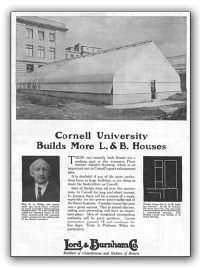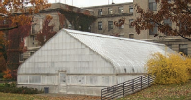For Liberty Hyde Bailey's vintage conservatory, the end appears near
For Liberty Hyde Bailey's vintage conservatory, the end appears near
Extending from the Plant Science Building toward Tower Road, Purple Conservatory No. 1023A is remarkable for its curved eaves and overlapping rows of windowpanes bearing love notes and other sentiments rubbed on the whitewashed glass. But on the crooked front door, a more official note states it is closed indefinitely. And by the time you read this, it may well be on its way to the junk heap.
A glimpse through window cracks doesn't tell the viewer much, except that Purple Conservatory No. 1023A is in an advanced state of neglect. The rarest and most valuable plants have been moved, but less lucky flora are toppled over or hanging in terra cotta pots that dangle like relics from a bygone colonial age.

Despite the ignominious title and sorry state of disrepair, the building is the conservatory of the Liberty Hyde Bailey Hortorium—a term coined by the famed Cornell botanist as a "place for the scientific study of garden plants, for their naming and their classification, and for their documentation." Today, the curved glass panes that give the building its distinctive shape have succumbed to time and the elements. The cypress molding is decayed, paint is peeling, metal frameworks and mechanical devices rusting. But before Ithaca's weather had its way, the conservatory's collections were a marvelous teaching exhibit of rare plants from around the world. A vast array of species were housed here—ferns, lycopods, horsetails, and of course Bailey's beloved palms, which reached the peak of the two-story-high conservatory. In fact, partly owing to Bailey's specimens, Cornell's experts wrote the definitive taxonomy of palms; not bad for a college in the middle of post-glacial New York.
Botanists like Bailey considered these spaces "living laboratories." Under his direction as dean (1903-13), the original College of Agriculture built more than a dozen greenhouses. But only two plant conservatories—structures that differ from greenhouses both in size and height to accommodate shrubs and trees—ever existed on campus. The first was a grand structure attached to Sage Hall that resembled, in miniature, the facilities at London's Kew Gardens; it was torn down without much fuss in 1923.
Purple Conservatory No. 1023A was built in 1931 by premier American conservatory architects Lord & Burnham. It was Bailey's baby, but planned in keeping with the times. "He was a very frugal man, and—aware of the Depression—kept the building modest," says CALS research support specialist Edward Cobb '73, who has enrolled a growing list of supporters hoping to save the conservatory. "We are working hard to ensure that Bailey's vision remains central to the campus." Cobb has sent out mass e-mailings, including one in mid-November that appealed for help to save the conserva-tory "for future generations." "If enough money can be raised, the best situation would be to totally renovate the conservatory greenhouse," he wrote. "This is an historic structure."

Historic to Cornell, yes. But the greenhouse is not on the State Historic Preservation Office's list of designated landmarks— so Cobb is spearheading an eleventh-hour battle to put it there.
CALS has $1.8 million available for a new greenhouse on the site of Purple 1023A, and bids to restore the original came in at twice that. Even Cobb concedes that the conservatory is dilapidated. But in addition to fearing that the structure will be torn down, he and his supporters worry that a replacement would be located on the outskirts of campus, far from plant science's teaching and research center.
The college's administration is clear that the building "will be razed," says senior associate dean Jan Nyrop. However, he added, "CALS is committed to providing a greenhouse conservatory in close proximity to the Plant Science Building," and is now studying its feasibility. But in a Q&A on the CALS website, administrators hedged their bets. Given the overall need to renew CALS greenhouses, it says, "rebuilding the conservatory on its current site may not be the best option or the best use of funds."
— Franklin Crawford


